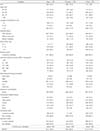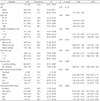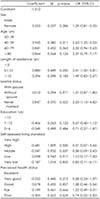Abstract
Objectives
Most studies on post-traumatic stress disorder (PTSD) have involved a small sample size and a specific traumatic event, with few studies reporting on subjects who have been continuously exposed to a traumatic event. Timely assessment and treatment are crucial for individuals chronically exposed to a traumatic event. Therefore, this study investigated the prevalence of PTSD and associated factors in all residents of Gangjeong village, who, recently, have been exposed to a traumatic event for a prolonged period.
Methods
The subjects of this study were the residents of Gangjeong village, who have been exposed to a traumatic event related to the construction of the Jeju Civilian-Military Complex Port. The survey included items related to general characteristics and PTSD symptoms, which were assessed using the Impact of Event Scale-Revised, Korean version.
Results
The prevalence of PTSD symptoms was 26.8% (95% confidence interval=23.54–30.04). Multivariate logistic regression analysis identified age, length of residence, and marital status as factors significantly associated with PTSD symptoms.
Conclusion
The prevalence of PTSD symptoms was higher among the study population than in the general population. Economically active age groups, people exposed to the traumatic event throughout their duration of residence in the village, and unmarried individuals were found to be more likely to develop PTSD symptoms. Mental, social, and financial support should be directed to the affected groups of individuals.
Figures and Tables
References
1. Breslau N, Davis GC, Andreski P, Peterson E. Traumatic events and posttraumatic stress disorder in an urban population of young adults. Arch Gen Psychiatry. 1991; 48:216–222.

2. Frazier P, Anders S, Perera S, Tomich P, Tennen H, Park C, et al. Traumatic events among undergraduate students: prevalence and associated symptoms. J Couns Psychol. 2009; 56:450–460.

3. Herman JL. Trauma and recovery: the aftermath of violence from domestic abuse to political terror. New York, NY: Basic Books;1992.
4. Taku K, Calhoun LG, Tedeschi RG, Gil-Rivas V, Kilmer RP, Cann A. Examining posttraumatic growth among Japanese university students. Anxiety Stress Coping. 2007; 20:353–367.

5. American Psychiatric Association. Diagnostic and statistical manual of mental disorders. 4th ed. Washington, DC: American Psychiatric Association;1994.
6. Lee JB, No ST. Listen to the song of Gururmbi. Seoul: ohmybook;2011. p. 272–279.
7. Gangjeong village Community. Peace grows in tears. Goyang: Danbi;2012.
8. Kim BH. President Moon visited Gangjeong village and said, “consolation… review the amnesty and reinstatement”. Hankyoreh [online]. 2018. 10. 11. cited 2019 Mar 11. Available from: http://www.hani.co.kr/arti/politics/bluehouse/865517.html.
9. Eun HJ, Kwon TW, Lee SM, Kim TH, Choi MR, Cho SJ. A study on reliability and validity of the Korean version of of impact of Event Scale-revised. J Korean Neuropsychiatr Assoc. 2005; 44:303–310.
10. kihasa.re.kr [homepage on the Internet]. Sejong: Korean Institute of Health and Social Affairs;cited 2019 Mar 11. Available from: www.kihasa.re.kr.
11. kostat.go.kr [homepage on the Internet]. Deajeon: Statistics Korea;cited 2019 Mar 11. Available from: http://kostat.go.kr/portal/korea/index.action.
12. Weiss DS, Marmar CR. The impact of event scale-revised. In : Wilson JP, Keane TM, editors. Assessing Psychological Trauma and PTSD. New York, NY: Guilford Press;1997. p. 399–411.
13. Horowitz M, Wilner N, Alvarez W. Impact of Event Scale: a measure of subjective stress. Psychosom Med. 1979; 41:209–218.

14. Lim HK, Woo JM, Kim TS, Kim TH, Choi KS, Chung SK, et al. Reliability and validity of the Korean version of the Impact of Event Scale-revised. Compr Psychiatry. 2009; 50:385–390.

15. Ministry of Health and Welfare. The Survey of Mental Disorders in Korea. Sejong: Ministry of Health and Welfare;2017.
16. Jeju Special Self-Governing Province. Study on the status of mental disorder in Jeju special self-governing province in 2015. cited 2019 Mar 11. Available from: https://www.jeju.go.kr/files/convert/201605/e085aa8c-30a5-4206-829d-df50c41d63c2.hwp.htm.
17. Neuner F, Schauer M, Karunakara U, Klaschik C, Robert C, Elbert T. Psychological trauma and evidence for enhanced vulnerability for posttraumatic stress disorder through previous trauma among West Nile refugees. BMC Psychiatry. 2004; 4:34.

18. Tol WA, Komproe IH, Thapa SB, Jordans MJ, Sharma B, De Jong JT. Disability associated with psychiatric symptoms among torture survivors in rural Nepal. J Nerv Ment Dis. 2007; 195:463–469.

19. Mollica RF, Wyshak G, Lavelle J. The psychosocial impact of war trauma and torture on Southeast Asian refugees. Am J Psychiatry. 1987; 144:1567–1572.

20. Breslau N, Chilcoat HD, Kessler RC, Davis GC. Previous exposure to trauma and PTSD effects of subsequent trauma: results from the Detroit Area Survey of Trauma. Am J Psychiatry. 1999; 156:902–907.

21. Creamer M, Burgess P, McFarlane AC. Post-traumatic stress disorder: findings from the Australian National Survey of Mental Health and Well-being. Psychol Med. 2001; 31:1237–1247.

22. Choi KS, Lim CK, Choi JW, Kang SK, Yum YT. Posttraumatic stress disorder among occupational accident patients. J Korean Neuropsychiatr Assoc. 2002; 41:461–471.
23. Oh SS, Kim SH, Shin HK, Jo YB, Choi JK, Kim KH, et al. Study on the living conditions and the aftereffect of the May 18 demovratic merits. Gwangju: The May 18 Memorial Foundation;2006.
24. Haskell SG, Gordon KS, Mattocks K, Duggal M, Erdos J, Justice A, et al. Gender differences in rates of depression, PTSD, pain, obesity, and military sexual trauma among Connecticut War Veterans of Iraq and Afghanistan. J Womens Health (Larchmt). 2010; 19:267–271.

25. Jingchu H, Biao F, Yonghui Z, Wenqing W, Jiawei X, Xifu Z. Gender differences in PTSD: susceptibility and resilience. In: Alvinius A, editor. Gender Differences in Different Contexts. London: Intech;2017. p. 21–42.
26. National Institute of Mental Health. Post-Traumatic Stress Disorder(PTSD). cited 2019 Mar 19. Available from: https://www.nimh.nih.gov/health/statistics/post-traumatic-stress-disorder-ptsd.shtml.
27. Ditlevsen DN, Elklit A. The combined effect of gender and age on post traumatic stress disorder: do men and women show differences in the lifespan distribution of the disorder? Ann Gen Psychiatry. 2010; 9:32.

28. Sadat Z, Abdi M, Aghajani M. Prevalence of posttraumatic stress disorder and related factors among patients discharged from critical care units in Kashan, Iran. Arch Trauma Res. 2015; 4:e28466.

29. Stuber ML, Meeske KA, Krull KR, Leisenring W, Stratton K, Kazak AE, et al. Prevalence and predictors of posttraumatic stress disorder in adult survivors of childhood cancer: a report from the childhood cancer survivor study. Pediatrics. 2010; 125:e1124–e1134.

30. Brewin CR, Andrews B, Valentine JD. Meta-analysis of risk factors for posttraumatic stress disorder in trauma-exposed adults. J Consult Clin Psychol. 2000; 68:748–766.

31. McCarroll JE, Fullerton CS, Ursano RJ, Hermsen JM. Posttraumatic stress symptoms following forensic dental identification: Mt. Carmel, Waco, Texas. Am J Psychiatry. 1996; 153:778–782.

32. Kim JH. Relations of perceived stress, cognitive set, and coping behaviors to depression: a focus on freshmen's stress experience. Korean J Psychol. 1988; 1:25–45.
33. Perry S, Difede J, Musngi G, Frances AJ, Jacobsberg L. Predictors of posttraumatic stress disorder after burn injury. Am J Psychiatry. 1992; 149:931–935.

34. Ursano RJ, McCaughey BG, Fullerton CS. Individual and community responses to trauma and disaster: the structure of human chaos. New York, NY: Cambridge University Press;1994. p. 3–30.




 PDF
PDF ePub
ePub Citation
Citation Print
Print





 XML Download
XML Download